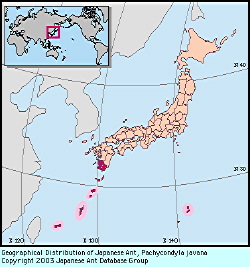
|
species
|
Pachycondyla javana
|
 |
Japanese Name
|
Tsushima-hari-ari
|
Original Reference
|
|
Mayr, G. (1867) Adnotationes in monographiam formicidarum Indo-Neerlandicarum. Tijdschrift voor Entomologie (2) 2 [10]: 33-117.
|
Synonym
|
|
Pachycondyla (Ectomomyrmex) japonica Emery, 1902),
Ectomomyrmex japonicus: Santsche, 1925,
Ectomomyrmex javanus Mayr, 1867,
Pachycondyla (Ectomomyrmex) javana: Emery, 1900,
Pachycondyla (Ectomomyrmex) japonica Emery, 1902,
Ectomomyrmex japonicus: Santsche, 1925,
Pachycondyla (Ectomomyrmex) astuta cambodjana Forel, 1911,
Ectomomyrmex denticeps Wheeler, 1929,
Pachycondyla (Ectomomyrmex) horni Forel, 1913,
Ectomomyrmex jananus race maternus Forel, 1900,
Ectomomyrmex sundaicus Mayr, 1867,
|
Description
|
|
The largest known Japanese ponerine ant. Total length of workers around 7 mm. The body generally black in color. Lateral margins of head forming blunt keels. Antennae 12-segmented. Head, mesosoma and petiole more or less heavily sculptured; the gaster smooth and shining. Mesopleuron subdivided by an oblique furrow.
|
Remarks
|
|
P. javana nests under stones at forest margins. Workers may be found foraging individually on the ground; they do not form trails, and are able to sting painfully. The male is characterised by the presence of a distinct V-shaped carination on the dorsal surface of the propodeum, derived from its anterior margin. P. javana is distributed mainly in tropical Asia. In Japan it was originally described from Tsushima I. as Pachycondyla japonica Emery. Wheeler (1928) recorded it from Honshu, but queried its true identity. P. javana is rather common on Tsushima I., but is not known from northern Kyushu. Its nomenclature is still uncertain. Yasumatsu (1962), for example, suggested that the species epithet sauteri was a possible synonym of javana, while Collingwood (1976) considered javana a junior synonym of astuta F. Smith. Terayama (1999) believed the Japanese species to be different from true P. javana, and identified it as Pachycondyla sp. The provisional species name javana is retained here, because the species is a member of the P. javana complex.
|
|

Distribution
|
|
Kyushu (southern part), Tsushima I., Nansei Is; Mainland China, Korean Peninsula, Taiwan, and part of SE Asia.
|
|
References
|
|
- Wheeler, W. M. (1928). Ants collected by Professor F. Silvestri in Japan and Korea. . Boll. Lab. Zool. Gen. Agrar. Portici, 21, 96-125.
- Yasumatsu, K. (1962). Notes on synonymies of five ants widely spread in the Orient. . Mushi, 36, 93-97.
- Collingwood, C. A. (1976). Ants (Hymenoptera, Formicidae) from North Korea. . Ann. Hist. Nat. Mus. Hung., 68, 295-309.
|
Editor
|
|
Original text by Kazuo Ogata and Masaaki Morisita. English translation by Kazuo Ogata, edited by Robert W. Taylor.
|
|